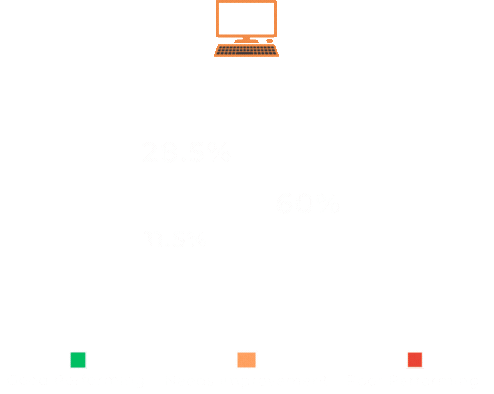General B2B Website Performance
Google PageSpeed Insights
The website performance score in this report is provided by Google's PageSpeed Insights, which measures how well a webpage performs based on various speed and UX metrics. This score ranges from 0 to 100, with higher scores indicating better performance.
Average B2B Website Performance
This combined score of both desktop and mobile website performance provides a holistic view of how well B2B websites are performing in terms of speed, usability, and technical optimisation.
Our research found that the average B2B Website performance score is 65.9 out of 100.
This score places the typical B2B website firmly within the “Needs Improvement” category, according to Google’s PageSpeed Insights grading criteria. The average score of 65.9 indicates that most B2B websites are not currently delivering a high-performing experience. While not critically poor, they fall short of Google’s preferred standards, which can hinder:
Organic search rankings
Mobile user engagement
Bounce rates and conversion success
Google’s algorithm rewards fast, well-optimised websites. A score below 90 can contribute to lower SERP visibility, especially for mobile-first indexing.
Considering only 3.7% of B2B websites managed to get this right, there is a considerable opportunity to differentiate B2B websites from their competitors.

What is a good Google PageSpeed Insights' score?
The PSI score is a core component of this report’s performance assessment, and it plays a critical role in how Google ranks pages in search results—particularly with the introduction of Core Web Vitals as ranking factors.
The PageSpeed Insights tool assigns a numeric score between 0 and 100, divided into three colour-coded categories:
| Score Range | Category | Meaning |
|---|---|---|
| 90–100 | ✅ Good | The website performs well and meets most of Google’s performance standards. |
| 50–89 | ⚠️ Needs Improvement | The site has moderate issues that negatively impact user experience. |
| 0–49 | ❌ Poor | Serious performance issues are present; major improvements are needed. |
Why should I care?

User Experience

SEO and Rankings

Lead Generation

Mobile Performance

General B2B Website Performance
Desktop vs Mobile Websites
One of the most revealing insights from the Growthlabs audit is the substantial disparity in Google’s PageSpeed Insights website performance between desktop and mobile platforms across the B2B sector. Although desktop devices remain prevalent in professional environments, mobile usage now accounts for approximately 35–45% of B2B web traffic.
Despite this shift, our findings indicate that B2B websites remain significantly under-optimised for mobile users. The following are the averages for both platforms:
- Desktop Average – 75.1
- Mobile Average – 57.1
While both platforms fall into Google’s “Needs Improvement” category, mobile performance lags 18 points behind desktop on average, representing a serious underinvestment in mobile optimisation across the B2B digital landscape.
What is more concerning is that only 3% of B2B mobile websites manage to obtain a good score.



Mobile - The Downfall of B2B Website Performance
It is clear that B2B websites are not well-optimised and have lower performance on mobile devices than on desktops. Although consumer-focused websites have higher mobile usage, B2B websites still get around 35%-45% of traffic from these devices. Underperformance on mobile is likely to have the following impact:
Lower Search Rankings: Google utilises mobile-first indexing, so poor mobile scores can negatively impact your overall visibility, even for desktop searches.
Reduced Engagement: Mobile users encountering slow, broken, or cluttered experiences are more likely to bounce without converting.
Brand Perception: A slow, non-optimised mobile site can signal inefficiency and outdated practices.
Missed Opportunities: Decision-makers increasingly use mobile devices outside standard work hours. A poor mobile site means lost leads.
General B2B Website Performance
Other Performance Stats
For instance, many visitors become frustrated by long waiting times even before a page fully loads, and slow loading speeds can lead to reduced engagement and higher bounce rates. The technical foundations of numerous B2B sites aren’t optimised as they should be. We also noticed some consistent trends regarding the platforms that businesses choose for their websites, with certain tools falling short in key speed and usability areas.

High Waiting Times
One of the most overlooked, yet critically important, aspects of website performance is server response latency, often referred to as waiting time. This metric measures the delay between a user’s request for a webpage and the first byte of data being received from the server—a factor known as Time to First Byte (TTFB).
In the context of B2B websites, where users expect fast and seamless interactions, high waiting times directly contribute to slower page loads, poor user experience, and reduced search engine rankings.
Our analysis revealed the following:
The average number of high waiting time pages per B2B website: 17
Percentage of websites with high waiting time pages: 37%
This indicates that over one-third of B2B websites contain multiple pages with excessive server delays, often affecting key landing pages, resource hubs, or conversion points.
Causes of High Waiting Times
The underlying causes of high waiting times are often technical and infrastructure-related. Common issues include:
Slow or overloaded hosting servers: Shared or under-resourced servers delay response times under heavy traffic loads.
Lack of caching: Each request is processed from scratch instead of being served from a cache.
Unoptimised database queries: Dynamic content generation leads to server-side delays.
Overuse of plugins or third-party scripts: Increases server processing time before responding to the browser.
Geographic distance from server: Users far from the host server may experience slower connections without a CDN (Content Delivery Network).
High Loading Time
While waiting time measures how fast a server responds, loading time captures the total duration a webpage takes to fully load and become interactive for the user. In the competitive B2B landscape, where trust, speed, and convenience are essential, high loading times can directly undermine lead generation and sales effectiveness.
Google defines a high loading time as any page that takes more than 4 seconds to fully render. From the user’s perspective, this delay feels sluggish and frustrating, often resulting in site abandonment before meaningful engagement can even begin.
Our research across the B2B sector uncovered a significant issue:
- The average number of high-loading time pages per website: 18
- Percentage of B2B websites with high loading time pages: 40%
This means nearly half of the audited websites have substantial delays in delivering content—many on key user entry points like homepages, service pages, and resource centres.
Why High Loading Time Matters
Loading time is a core part of Google’s Page Experience signal and is strongly correlated with both user satisfaction and conversion performance. Pages that exceed the 4-second mark are more likely to suffer from:
Increased bounce rates: Users are likely to abandon pages that load too slowly.
Reduced search visibility: Google penalises pages with poor load performance.
Lower user engagement: Visitors are less likely to scroll, click, or complete forms.
Wasted ad spend: Paid campaigns pointing to slow pages can drive up cost-per-click without returns.
Amazon found that every 100ms increase in load time cost them 1% in sales—a trend that translates proportionally across B2B sites where lead capture is the primary goal.
Causes of High Loading Time
The underlying causes of high loading commonly issues include:
Uncompressed high-resolution images: Slows visual rendering dramatically.
Too many third-party scripts: Adds processing burden (e.g., chatbots, analytics, trackers).
Poor hosting infrastructure: Increases server response time and delays page rendering.
Bloated CSS and JavaScript files: Delays time to interactivity.
Lack of lazy loading or deferred scripts: Causes full-page resources to load before visible content appears.
B2B Website Builders
The choice of content management system (CMS) or website builder has a significant impact on the performance, scalability, and SEO readiness of a B2B website. Different platforms offer varying degrees of flexibility, technical control, and optimisation potential—factors that directly influence both user experience and digital visibility.
As part of our audit, we analysed the CMS and web builder platforms used by B2B companies across our sample. The findings reveal clear trends in platform adoption, as well as distinct performance strengths and limitations associated with each.
WordPress stands out as the dominant choice, powering nearly half of all audited B2B websites. Its popularity is largely due to its open-source nature, massive plugin ecosystem, and ability to scale when configured correctly.

Benchmarks make us better
Analyse your website!
Complete the form below and we will send you a tailored website and SEO report, obligation free.
Your report will be send via email, typically within 24 (business) hours of request*

